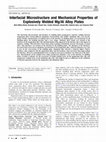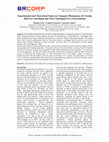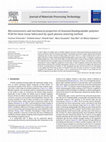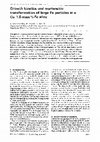Papers by Yoshimi Watanabe

Quarterly Journal of The Japan Welding Society, 2023
In this study, the effects of annealing on the interfacial microstructure, mechanical properties ... more In this study, the effects of annealing on the interfacial microstructure, mechanical properties and residual stress of explosively welded AZ80 magnesium alloy and A6005C aluminum alloy cladding plate were investigated. After explosive welding, thin interlayer composed by intermetallic compound, i.e., γ-Mg 17 Al 12 phase, was formed at the interface of the cladding plate. After annealing at both 373 K and 473 K, the thickness of the interlayer increased. With annealing at 473 K, the interlayer changed from a one-layer structure consisting of γ-Mg 17 Al 12 phase to a two-layer structure consisting of γ-Mg 17 Al 12 phase and β-Al 3 Mg 2 phase, resulting in the decrease in shear strength. As a result of nanoindentation measurement at the interface, the hardness was remarkably large in the β-Al 3 Mg 2 phase. It was suggested that this phase became the crack initiation site for brittle fracture and the shear strength decreased. Measurements of the residual stress using synchrotron radiation X-rays at the interface of cladding plate revealed the tendency of the generation of tensile residual stress on AZ80 magnesium alloy side and compressive residual stress on A6005C aluminum alloy side. After annealing at 473 K, residual stresses in AZ80 magnesium alloy side and A6005C aluminum alloy side changed to compressive and tensile stress, respectively, and the stress values became smaller in both cases. On the other hands, after annealing at 373 K, compressive residual stress was observed in both AZ80 magnesium alloy side and A6005C aluminum alloy side.

Journal of Japan Institute of Light Metals, May 15, 2022
In this study, effects of heterogeneous nucleation site particles on density, microstructure and ... more In this study, effects of heterogeneous nucleation site particles on density, microstructure and hardness were studied in the pure aluminum samples additively manufactured by laser-based powder bed fusion (PBF-LB) method with a small amount of TiC particles. It was found that higher density of the sample was found by addition of small amount of TiC particles. It was also found that the sample containing 1.0 vol% TiC particles has the most refined microstructure. In addition, the samples fabricated with 0 vol% and 0.1 vol% TiC particles have <101> texture along building direction, whereas <100> texture was observed for the samples with 0.5 vol% and 1.0 vol% TiC particles. As the volume fraction of TiC particles increases, the hardness of the samples was also increased. Higher hardness in the samples with TiC particles was mainly caused by not reinforcement effects of TiC particles but refinement of grain structure by heterogeneous nucleation.

Journal of Materials Engineering and Performance, Apr 12, 2022
The interfacial microstructure and hardness of cladding plates produced by explosive welding betw... more The interfacial microstructure and hardness of cladding plates produced by explosive welding between magnesium alloys having different aluminum concentrations and A6005C aluminum alloy were investigated. Further, measurements of residual stress at the interface of cladding plates were performed. In all cladding plates, the bonding interface had a wavy shape. Adiabatic shear bands were formed at the interface on the magnesium alloy side and deformation twins appeared at the interface due to the impact of explosive welding. Microstructure observation using scanning transmission electron microscope revealed that a thin interlayer was formed at the interface in all cladding plates. The thickness of the interlayer increased with an increase in aluminum concentration in the magnesium alloy, while the thickness was 1 μm or less. In the cross-section of the cladding plate, aluminum alloy showed a relatively higher Vickers hardness value compared with the magnesium alloy, and the hardness value increased when approaching the interface. However, nanoindentation tests revealed no increase in hardness was observed at the interface. Measurements of the residual stress using synchrotron radiation x-rays at the interface of cladding plates revealed a tendency for the occurrence of tensile residual stress on the magnesium alloy side and compressive residual stress on the aluminum alloy side. This might be due to a difference in the coefficient of thermal expansion between the magnesium and aluminum alloys. Keywords aluminum, dissimilar metal joining, explosive welding, interlayer, magnesium, residual stress This article is an invited submission to the Journal of Materials Engineering and Performance selected from presentations at the symposium "Joining," belonging to the area "Processing" at the European Congress and Exhibition on Advanced Materials and Processes (EUROMAT 2021), held virtually from September 12-16, 2021, and has been expanded from the original presentation.
Physica Status Solidi B-basic Solid State Physics, Sep 1, 2022

Materials transactions, Apr 1, 2022
This study reports on an interfacial design method of CuSiC composites by means of nano-diamond/S... more This study reports on an interfacial design method of CuSiC composites by means of nano-diamond/SiC composite particles in meltinfiltration process. In the case of CuSiC composites fabricated by melt-infiltration process, reaction layers consisting of spherical carbon particles and CuSi solid-solution alloys were observed as SiC particles reacted with melt Cu. Formation of reaction layers is not appropriate to obtain the predesigned characteristics such as physical and mechanical properties of the CuSiC composites. To overcome this problem, nanodiamonds, which were chemically inert with Cu, were bonded to the surfaces of SiC particles by amorphous silica as a bond material in order to shield the SiC particles from reacting with melt Cu. It was found that this shielding method enabled us to disperse SiC particles homogeneously in the Cu matrix without reaction layers. This interfacial design based on the composite particles should be expected to be applied to a promising mass production technology of metal-matrix composites (MMCs) due to its short processing time and large amount of production for processing composite particles.

Functionally Graded Materials (FGMs) are high performance composite materials, in which physical ... more Functionally Graded Materials (FGMs) are high performance composite materials, in which physical and/or chemical properties of these material structures are graded in the several directions. Centrifugal solid-particle method by use of the centrifugal casting device is one of the effective fabrication methods. The casting mold which includes reinforcement particles and molten metal is centrifuged and the particles move in the mixture due to density differences of these materials. However, there is no information on these particle motions in the centrifugal force field. In this study, theoretical and experimental study is performed on suspension particle motion in both the axially rotating drum and the stable liquid tank. The particle velocity of the circular disk is measured by PTV (Particle Tracking Velocimetry) method and is predicted by BBO (Basset-Boussinesq-Ossen) equation. It is found that (1) as time progresses, one side of the disk in the axially rotating drum is attracted to...
Key Engineering Materials, Aug 1, 2012
This study aims to investigate the microstructure and mechanical properties of Ti-ZrO2 composites... more This study aims to investigate the microstructure and mechanical properties of Ti-ZrO2 composites and ZrO2/Ti functionally graded materials (FGMs) fabricated by spark plasma sintering (SPS). SPS has been conducted in a vacuum at 1400 oC under the uniaxial pressure of 30 MPa. Mechanical properties such as hardness and elastic modulus of Ti-ZrO2 composites have been systematically investigated using micro-Vickers and nanoindentation. The experimental results demonstrate that the mechanical properties of Ti are dramatically improved by an addition of small amount of ZrO2. There is almost no effect from the presence of Y2O3 in ZrO2 on the hardness of Ti-ZrO2 composites. ZrO2/Ti FGMs have been successfully fabricated, and mechanical properties of the FGMs have been examined.
Journal of Japan Institute of Light Metals
The effects of magnesium alloy compositions on the interfacial microstructure, corrosion resistan... more The effects of magnesium alloy compositions on the interfacial microstructure, corrosion resistance and mechanical properties of explosively welded magnesium alloys and aluminum alloy were investigated. The bonding interface had a periodic wavy shape. Thin interlayer consists of intermetallic compound, γ-Mg 17 Al 12 phase, was formed at the bonding interface in all samples. When the aluminum concentration in the magnesium alloy is low, the intermediate layer at the bonding interface is thin and intermittently formed, but when the aluminum concentration in the magnesium alloy was high, the intermediate layer was relatively thick and uniformly formed, resulting in high bonding strength. In all samples, brittle fracture surface was observed and the presence of γ-Mg 17 Al 12 phase was confirmed on the fracture surfaces.

Journal of multifunctional composites, 2014
The aim of this study is to investigate thermo-mechanical response of ZrO 2 /Ti functionally grad... more The aim of this study is to investigate thermo-mechanical response of ZrO 2 /Ti functionally graded materials (FGMs) fabricated by spark plasma sintering (SPS) based on a mean-field micromechanics model, which takes account of micro-stress relaxation due to interfacial diffusion between ceramic and metal phases as well as creep of both phases. A resistance to cyclic thermal shock loadings of FGMs with different compositional gradation patterns including Ti-rich, linear and ZrO 2-rich gradation patterns has been investigated. The results demonstrate that Ti-rich FGMs show superior properties among the tested FGM samples. Mean-field micromechanics-based examinations reveal that the range and ratio of thermal stresses in ZrO 2 surface layers in FGMs can affect cyclic thermal shock fracture behaviour but not mean thermal stresses. Creep of ZrO 2 have a large influence on dependence of the range and ratio of thermal stresses in ZrO 2 surface layers on compositional gradation patterns in the FGMs.
MATERIALS TRANSACTIONS, 2013
Addition of AlTi alloy refiners into an Al melt induces grain refinement of ¡-Al grains in as-cas... more Addition of AlTi alloy refiners into an Al melt induces grain refinement of ¡-Al grains in as-cast pure Al. In this study, the effects of cold rolling for the AlTi alloy refiners on the grain refinement of as-cast pure Al were investigated. The Al 3 Ti particles in the refiners, which act as nuclei for the ¡-Al grains, were fragmented by cold rolling. Grain size of the ¡-Al grains is decreased as increasing the reduction ratio of the refiners. This decrease in grain size is due to the increase in the number of Al 3 Ti particles in the refiners. The mechanical properties of the as-cast pure Al are also improved as a result of its grain refinement. In particular, the wear properties of the as-cast pure Al were drastically improved. It is concluded that the cold rolling for the refiners is an effective process to enhance its grain refinement ability.
Nanocomposites with Unique Properties and Applications in Medicine and Industry, 2011
MATERIALS TRANSACTIONS, 2012
Grain refinement during equal-channel angular pressing (ECAP) was studied in a commercial Al5.8%M... more Grain refinement during equal-channel angular pressing (ECAP) was studied in a commercial Al5.8%Mg0.3%Sc alloy at temperatures from 473 to 723 K (³0.50.8T m). The samples were quenched in water in every ECAP pass, which is a conventional cyclic process. ECAP to ¾ = 12 resulted in ultrafine-grained structures developed uniformly at high strains at 473 and 723 K, while processing at 573 K led to the evolution of a duplex grain structure containing partially much coarser grains. In contrast, ECAP process continuously carried out to ¾ = 12 without interruption at 573 K, resulted in development of a uniform ultrafine-grained structure. Effects of processing regimes on microstructural evolution in the AlMgSc alloy are discussed.

International Journal of Materials and Product Technology, 2011
ABSTRACT We are developing functionally graded grinding wheels fabricated by a centrifugal mixed-... more ABSTRACT We are developing functionally graded grinding wheels fabricated by a centrifugal mixed-powder method. As a first step of this fabrication method, a powder mixture of abrasive particles and metal matrix particles is inserted into a spinning mould. After that, a metal matrix ingot is melted and then the molten metal matrix is poured into the spinning mould with the powder mixture. As a result, the molten metal matrix penetrates into the space between the particles due to the pressure exerted by the centrifugal force. At the same time, the metal matrix powder is melted by the heat from molten matrix poured from the crucible. Finally, a ring-shaped sample with abrasive particles distributed on its surface (functionally graded grinding wheel) can be obtained. In this study, functionally graded grinding wheel fabricated by the centrifugal mixed-powder method will be reported. © 2011 Inderscience Enterprises Ltd.
Journal of the Japan Institute of Metals and Materials, 2014
In our previous study, high strength brass pipes were fabricated by the centrifugal casting with ... more In our previous study, high strength brass pipes were fabricated by the centrifugal casting with machining chips. It was found that the obtained centrifugal casts have smaller microstructures. This study was carried out to discuss the origin of the refined microstructure. For this purpose, a and b brass machining chips and molten a brass where primary crystal was a phase and a+b brass where primary crystal was b phase were used, and systematical casting experiments were carried out. It was found that the grain sizes of a and b matrix casts with a and b brass machining chips, respectively, were smaller than those of a and b matrix casts with b and a brass machining chips, respectively. These results can be explained by disregistry value between machining chip phase and primary crystal phase.

Journal of Materials Processing Technology, Dec 1, 2011
Ti and Ti alloys are widely used as metallic implants, because of their good mechanical propertie... more Ti and Ti alloys are widely used as metallic implants, because of their good mechanical properties and nontoxic behavior. However, they have problems as the implant-materials, namely, high Young's modulus comparing that of bone and low bonding ability with bone. There is a need to develop the Ti and Ti alloys with lower Young's modulus and good bonding ability. In previous study, Ti composite containing biodegradable poly-l-lactic-acid (PLLA) fiber has been fabricated to improve these problems. However, this composite has low strength because of the imperfect sintering of Ti matrix. To improve its strength, sintering of Ti matrix should be completed. In this study, Ti-NaCl composite material was fabricated by spark plasma sintering (SPS) method using powder mixture of Ti and NaCl to complete the sintering of Ti matrix. To obtain porous Ti samples, Ti-NaCl composite were put into hot water of 317 K. The porous Ti was dipped into PLLA melt in order to introduce PLLA into the pores of porous Ti. Finally, Ti/PLLA composite was obtained, and PLLA plays a role as reinforcement of Ti matrix. It was found that the Ti/PLLA composite has gradient structure and mechanical properties.
Formation of the compositional gradient in FGMs fabricated by centrifugal casting method depends ... more Formation of the compositional gradient in FGMs fabricated by centrifugal casting method depends mainly on the processing temperature and the applied centrifugal force. According to the initial state of the dispersed second phase at the processing temperature, CCM-FGMs can be classified into two categories. One is the FGM fabricated by centrifugal solid-particle method, and the other one is the FGM made by centrifugal in-situ method. In previous study, it has been reported that microstructure of Al-Al3Ti FGMs by centrifugal in-situ method was different from that by centrifugal solid-particle method. However, difference of mechanical property due to processing method is still unclear. In this study, mechanical properties, such as hardness and wear property of Al-Al3Ti FGMs fabricated by centrifugal solid-particle method and in-situ method were evaluated.
Applied Mechanics and Materials, 2013
In this paper, creep analysis for a thick-walled cylinder made of functionally graded materials (... more In this paper, creep analysis for a thick-walled cylinder made of functionally graded materials (FGMs) subjected to thermal and internal pressure is carried out. The structure is replaced by a system of discrete rectangular cross-section ring elements interconnected along circumferential nodal circles. The property of FGM is assumed to be continuous function of volume fraction of material composition. The creep behavior of the structures is obtained by the use of an incremental approach. The obtained results show that the property of FGM significantly influences the stress distribution along the radial direction of the thick-walled cylinder as a function of time.
MRS Proceedings
ABSTRACTThe fabricating conditions for the in-situ Al-Si base composite by the centrifugal castin... more ABSTRACTThe fabricating conditions for the in-situ Al-Si base composite by the centrifugal casting method (CCM) have been examined. The crystallized Si particles with a lower density distribute in a gradient fashion as densely on the inner and thinly on the outer side of the wall of the cylindrical CCM-composite. Synthetically, the 25 mol% Si composite is recommended for the application like the engine liner.

J Mater Sci, 1991
The growth kinetics and martensitic transformation induced by simple cooling of large Fe particle... more The growth kinetics and martensitic transformation induced by simple cooling of large Fe particles in Cu-1.5 mass % Fe single crystals aged at 973 K for up to 60 days are examined by transmission electron microscopy and magnetic measurement. The growth kinetics of large Fe particles can be described by the Lifshitz-Slyozov-Wagner theory and the interfacial energy between the Fe particles and the Cu matrix is estimated as 0.24 to 0.40 J m-2. The volume fraction of r particles increases with the mean particle size and with lowering of the cooling temperature. The critical sizes below which the transformation by simple cooling does not occur, are found to be 290 and 350 nm for specimens cooled to 77 K and room temperature, respectively. The saturation magnetization of the Cu-Fe alloy containing large r particles increases by further annealing of the cooled specimens. These facts imply that r particles are not produced during the prolonged ageing but are formed martensitically during the cooling process.

Uploads
Papers by Yoshimi Watanabe